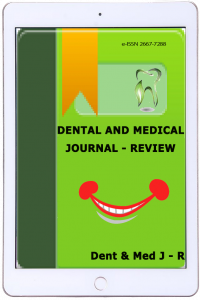ORAL ÜLSERASYONLAR: ETYOLOJİ, SINIFLANDIRMA, YÖNETİM VE TEŞHİS ALGORİTMASI
Anatomik konumu, zengin damar yapısı ve ağız boşluğunun çeşitli işlevleri nedeniyle, ağız mukozası çeşitli etkenlere maruz kalır. Bunlar arasında çiğneme veya ağızdan alınan cihazlardan kaynaklanan travma, yiyeceklere / ilaçlara bağlı lokal tahriş, sistemik olarak alınan ilaçlara (kan yoluyla) maruz kalma, bulaşıcı ajanlar ve otoimmün ve diğer sistemik hastalıkların etkileri sayılabilir. Bu etkenler, hiperkeratozdan likenoid lezyonlara ve açık ülserasyona kadar değişen çeşitli oral belirtilere neden olabilir. Bu derleme, tekrarlayan oral ülserasyona neden olabilecek daha yaygın durumların etiyolojisini, patogenezini, tanısını ve yönetimini tartışacaktır.
Anahtar Kelimeler:
oral mukoza, oral patoloji, ülserasyonlar
ORAL ULCERATIONS: ETIOLOGY, CLASSIFICATION, MANAGEMENT AND DIAGNOSTİC ALGORITHM
Owing to the anatomic location, rich vasculature, and various functions of the oral cavity, the oral mucosa is exposed to a variety of insults. These include trauma from chewing or oral appliances, local irritation secondary to foods/drugs, exposure to systemically ingested drugs (through the blood supply), infectious agents, and effects of autoimmune and other systemic diseases. These insults can result in a variety of oral manifestations, ranging from hyperkeratosis to lichenoid lesions to frank ulceration. This review will discuss the etiology, pathogenesis, diagnosis, and management of the more common conditions that can lead to recurrent oral ulceration.
Keywords:
oral mucosa, oral pathology, ulcerations,
___
- 1. Davies AN, Thompson J. Parasympathomimetic drugs for the t reat-ment of salivary gland dysfunction due to radiotherapy. Cochrane Database Syst Rev. 2015;CD00378 2. Barbe AG , Schmidt-Park Y, Hamacher S, Derman SH, Noack MJ. Efficacy of GUM® Hydral versus Biotène® O ralbalance mouth-washes plus gels on symptoms of medication- induced xerostomia: a randomized, double- blind, crossover study. Clin Oral Investig. 2017;2 2(1):169-180.
- ISSN: 2667-7288
- Yayın Aralığı: Yılda 3 Sayı
- Başlangıç: 2019
- Yayıncı: Mesut TUZLALI
Sayıdaki Diğer Makaleler
İMPLANT DESTEKLİ HAREKETLİ PROTEZLER
Begüm KARADEMİR, Ayşe KOÇAK-BÜYÜKDERE
ORAL ÜLSERASYONLAR: ETYOLOJİ, SINIFLANDIRMA, YÖNETİM VE TEŞHİS ALGORİTMASI
Hamed FARSIANI, Denız ERDIL, Melıke CAMGOZ, Nilsun BAĞIŞ
HAMİLELİKTE VE YENİ DOĞAN ÇOCUKLARDA AĞIZ DİŞ SAĞLIĞI
Kamile Nur TOZAR, Merve ERKMEN ALMAZ
